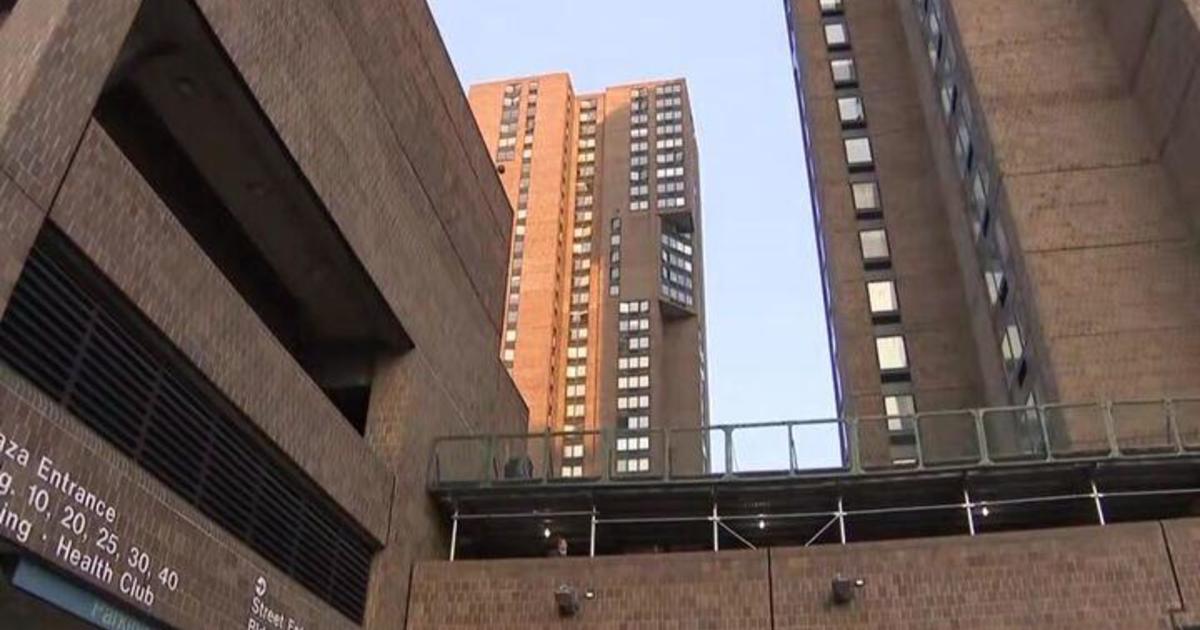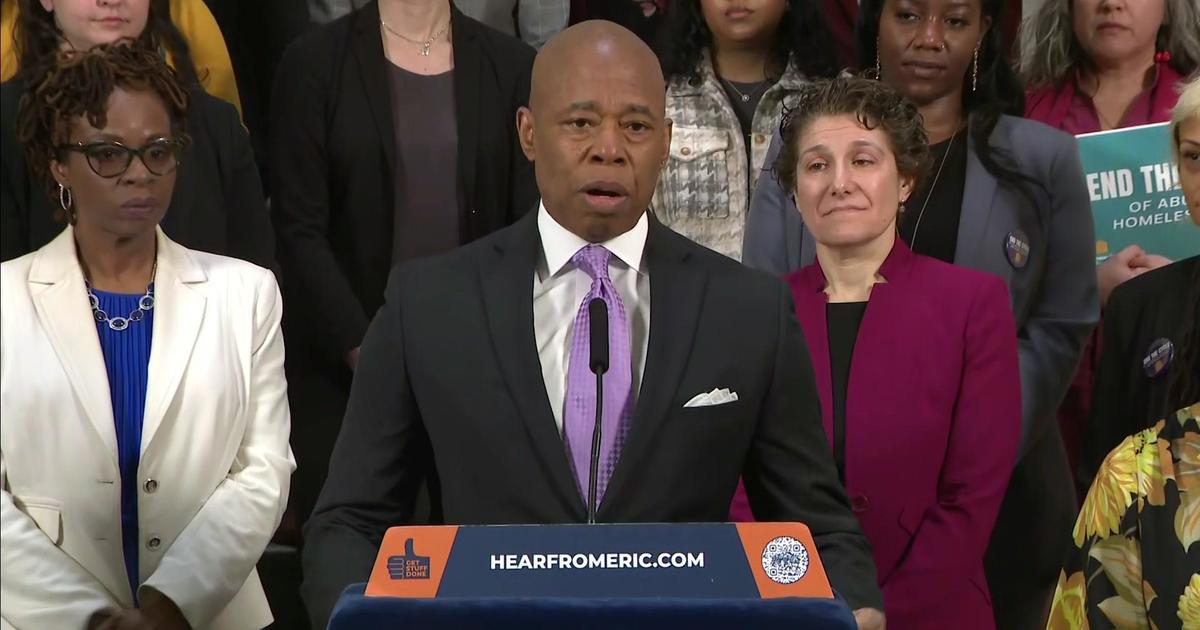Nearly 100 Homeless Removed From Streets In Frigid Weather Under Cuomo's Order
NEW YORK (CBSNewYork/AP) -- Nearly 100 homeless people were taken off the streets in the bitter cold Tuesday under Gov. Andrew Cuomo's mandate.
Meanwhile, as CBS2 Political Marcia Kramer reported, Mayor Bill de Blasio has appointed a new deputy mayor to deal with the city's homelessness crisis.
Cuomo's executive order went into effect at midnight Tuesday morning. Believed to be the only one of its kind in any city or state, it requires communities to reach out to their street homeless populations and take those people to shelters, voluntarily or not, once the temperature drops to 32 degrees Fahrenheit or below.
But the order has faced resistance, including from many homeless people who say they will not stay in city shelters because they are dirty or dangerous.
"I don't want to, I think they're dirty," said Jeanne Oneal, who was determined to sleep on the street. "I have on a sweater, I layer dress and I'm not cold at all."
A man named Jose said outreach people have offered to help, but he declines. He said he usually spends cold nights in the subway.
"I was given that opportunity quite a few times, well I'll say once or twice, and I never did report," he told 1010 WINS' Juliet Papa.
During the day Tuesday, another man was seen at Broadway and 54th Street in what seemed to be an encampment he had erected. Police and the Mayor's office outreach teams apparently overlooked him in trying to get the homeless off the streets in the cold.
For Joe Hallmark's homeless outreach teams, the day began well before dawn, WCBS 880's Marla Diamond reported.
"We start our morning shift at 5:30 so that we can get out there just as people are waking up, we're engaging them," he said.
The temperature was no more than 11 degrees with wind chills in the single digits, but the outreach team's offer for shelter was still turned down by a homeless person in Columbus Circle.
"It's too dangerous. It's too dangerous. The staff there, they're not there to work," the man said.
The team will return to the spot every two hours in case he changes his mind, Diamond reported.
"We nor the police actually have the authority to remove a competent individual from the streets," Hallmark said.
The prospect of forcible removals from the streets also raised deep worries among advocates for the homeless.
"Put simply, being homeless is not a crime,'' said Mary Brosnahan, president of the Coalition for the Homeless in New York, who warned that aggressive measures would push "the most marginalized homeless men and women further away from the very networks needed to engage them.''
Cuomo, who acknowledged some of the push back, said the state will do its part to ensure shelter safety.
"If shelters aren't up to code, then we are going to be very diligent in our inspection and management of the existing shelter system," he said.
But Mayor de Blasio said the governor's order wasn't necessary. He said bringing homeless in from the cold is a policy that had already been in place.
"The NYPD and the outreach program, if they believe someone is in real danger, they have the right to bring them in and they have been bringing them in," he said.
Under current state law, a police officer or outreach worker can take people from the street only if they appear to be in imminent danger or display signs of mental illness.
Coincidentally, on what was the city's first Code Blue day when it is acceptable to use force to get the homeless into shelters, Mayor de Blasio announced that a new deputy mayor for health and human services has been appointed.
Dr. Herminia Palacio replaces Lilliam Barrios-Paoli, who quit in frustration on the belief that the mayor was more interested in his national profile.
"This is an auspicious moment for this administration," de Blasio said.
With his newfound focus on the homeless, de Blasio said 97 people were removed from streets and taken to either shelters, hospitals or other safe havens between 8 p.m. and 8 a.m. Monday night into Tuesday morning. Only one of them was removed forcibly, de Blasio said.
An additional 101 people were taken to designated emergency rooms for medical care, 1010 WINS Al Jones reported.
Homelessness experts said the city should use Code Blue to convince the normally service-resistant street homeless to let the city help them.
"If finally we're able to convince them to come in, let's treat them sort of like a special customer, you know?" said Robert Mascali, former Deputy Commissioner of the city's Department of Homeless Services. "Let's show them that we're here for them -- there's nothing to be afraid of. We're going to treat your mental illness. We're going to treat your physical illness."
But the city is up against the wall in the convincing department.
"I don't like shelters, because shelters are like prisons," said Orlando Vance, who is homeless. "You live in a shelter, you live with criminals, crazy people, people that don't want to wash."
The mayor also admitted Tuesday that city shelters are not all wonderful places.
"Some still have problems – there's no question," he said. "The perception certainly hangs in the air that some of them are not safe enough."
Meanwhile, Maria Foscarinis, executive director of the National Law Center on Homelessness and Poverty, said there was no other U.S. municipality that had adopted a broad rule of removing people from the streets when it gets cold.
"The approach of the order is misguided,'' Foscarinis said. "It's a positive thing that (Cuomo) understands the urgency of doing something to help homeless people. But what's needed is permanent housing and services, not these kind of tactics.''
Cuomo was moved to act amid a growing homelessness crisis in New York City, which houses about 58,000 people in shelters and has another 3,000 to 4,000 people living on the streets. Six homeless people suffered cold-weather-related deaths in the city during the winter of 2013-14, the last season for which statistics are available.
Thirty years ago, then-Mayor Ed Koch tried to relocate the city's homeless but faced massive legal obstacles. The state's Mental Hygiene Law requires police to interview and determine mental capacity before taking a homeless person into custody; if the person appears to suffer from mental illness, he could be taken to a hospital or mental institution for evaluation.
Cuomo aides said Sunday, shortly after the order was issued, that state officials were interpreting the law to mean anyone who chose to turn down shelter in favor of sleeping outside in freezing temperatures inherently displayed some degree of mental illness and could therefore be removed. The governor's office later appeared to walk back that interpretation.
"Obviously, the order does not mandate involuntary commitment for competent individuals,'' Cuomo's counsel, Alphonso David, said in a written statement.
The Department of Justice's civil rights division has increasingly cracked down on municipalities for enacting laws criminalizing sleeping on public streets even as many U.S. cities are battling a surge of homelessness during the dead of winter.
Mayor de Blasio said he thinks giving police officers mental health training will help get the street homeless to seek help, and he agreed with Mascali that Code Blue, which brings people to shelters who might not ordinarily go, may help convince the homeless to stay and not flee on the first warm day.
(TM and © Copyright 2016 CBS Radio Inc. and its relevant subsidiaries. CBS RADIO and EYE Logo TM and Copyright 2016 CBS Broadcasting Inc. Used under license. All Rights Reserved. This material may not be published, broadcast, rewritten, or redistributed. The Associated Press contributed to this report.)



